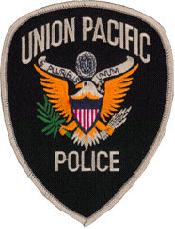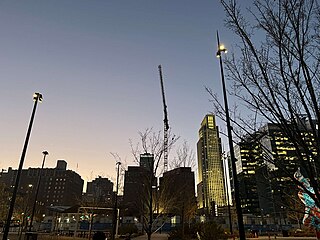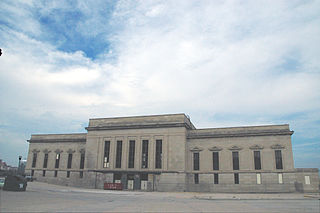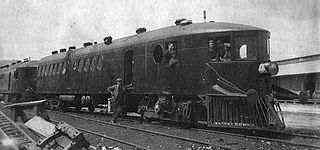
Omaha is the most populous city in the U.S. state of Nebraska and the county seat of Douglas County. It is in located in the Midwestern United States along the Missouri River, about 10 mi (15 km) north of the mouth of the Platte River. The nation's 40th-most populous city, Omaha had a population of 486,051 as of the 2020 census. It is the anchor of the eight-county Omaha–Council Bluffs metropolitan area, which extends into Iowa and is the 58th-largest metro area in the United States, with a population of 967,604. Furthermore, the greater Omaha–Council Bluffs–Fremont combined statistical area had 1,004,771 residents in 2020. Omaha is ranked as a global city by the Globalization and World Cities Research Network, which in 2020 gave it "sufficiency" status.

The Union Pacific Railroad is a Class I freight-hauling railroad that operates 8,300 locomotives over 32,200 miles (51,800 km) routes in 23 U.S. states west of Chicago and New Orleans. Union Pacific is the second largest railroad in the United States after BNSF, with which it shares a duopoly on transcontinental freight rail lines in the Western, Midwestern and West South Central United States.

BNSF Railway is the largest freight railroad in the United States. One of six North American Class I railroads, BNSF has 36,000 employees, 33,400 miles (53,800 km) of track in 28 states, and over 8,000 locomotives. It has three transcontinental routes that provide rail connections between the western and eastern United States. BNSF trains traveled over 169 million miles in 2010, more than any other North American railroad.

Metra is the primary commuter rail system in the Chicago metropolitan area serving the city of Chicago and its surrounding suburbs via the Union Pacific Railroad, BNSF Railway, and other railroads. The system operates 243 stations on 11 rail lines. It is the fourth busiest commuter rail system in the United States by ridership and the largest and busiest commuter rail system outside the New York City metropolitan area. In 2023, the system had a ridership of 31,894,900, or about 152,400 per weekday as of the fourth quarter of 2023. The estimated busiest day for Metra ridership occurred on November 4, 2016—the day of the Chicago Cubs 2016 World Series victory rally.

The Iowa Interstate Railroad is a Class II regional railroad operating in the central United States. The railroad is owned by Railroad Development Corporation of Pittsburgh, Pennsylvania.

The Union Pacific Police Department (UPPD) is a private railroad police department and the law enforcement agency of the Union Pacific Railroad, headquartered in Omaha, Nebraska. The UPPD is one of seven American Class I railroad law enforcement agencies, alongside those of Amtrak, BNSF, CSX, Canadian National, CPKC, and Norfolk Southern.

Omaha station, located at 1001 South 10th Street in downtown Omaha, Nebraska, is a historically and culturally significant landmark, and is listed on the National Register of Historic Places, which is currently used as the studio facility for Omaha's ABC affiliate, television station KETV. When it was opened in 1898, this Italianate style building, designed by Thomas Rogers Kimball, was hailed by newspapers around the world for its grand architecture and accommodations. The station is a contributing property to the Omaha Rail and Commerce Historic District, and sits southeast of the Old Market, and immediately north of Little Italy.

The economy of Omaha, Nebraska is linked to the city's status as a major commercial hub in the Midwestern United States since its founding in 1854. Dubbed the "Motor Mouth City" by The New York Times, Omaha is widely regarded as the telecommunications capital of the United States. The city's economy includes agriculture, food processing, insurance, transportation, healthcare and education. Warren Buffett of Berkshire Hathaway has lived in Omaha all of his life, as have the ConAgra Foods, Union Pacific Railroad and Mutual of Omaha Companies, and Kiewit Corporation, all Fortune 500 corporations.

Downtown Omaha is the central business, government and social core of the Omaha–Council Bluffs metropolitan area, U.S. state of Nebraska. The boundaries are Omaha's 20th Street on the west to the Missouri River on the east and the centerline of Leavenworth Street on the south to the centerline of Chicago Street on the north, also including the CHI Health Center Omaha. Downtown sits on the Missouri River, with commanding views from the tallest skyscrapers.

Transportation in Omaha, Nebraska, includes most major modes, such as pedestrian, bicycle, automobile, bus, train and airplane. While early transportation consisted of ferries, stagecoaches, steamboats, street railroads, and railroads, the city's transportation systems have evolved to include the Interstate Highway System, parklike boulevards and a variety of bicycle and pedestrian trails. The historic head of several important emigrant trails and the First transcontinental railroad, its center as a national transportation hub earned Omaha the nickname "Gate City of the West" as early as the 1860s.

Railroads in Omaha, Nebraska, have been integral to the growth and development of the city, the state of Nebraska, the Western United States and the entire United States. The convergence of many railroad forces upon the city was by happenstance and synergy, as none of the Omaha leaders had a comprehensive strategy for bringing railroads to the city.

The McKeen Railmotor was a 6-cylinder self-propelled railcar or railmotor. When McKeen Company of Omaha, Nebraska, U.S.A., first unveiled the car in 1905, the McKeen was among the first engines with a distillate-fueled motor. Revisions to the McKeen car led to the modern self-propelled gasoline rail-motor vehicle, and the "contours of the porthole windows, the front-mounted gasoline engines, and other features anticipated the streamline concept."
Augustus Kountze was an American businessman based in Omaha, Nebraska, Kountze, Texas and New York City. He founded a late 19th-century national banking dynasty along with his brothers Charles, Herman and Luther.
The Omaha Belt Line was a 15-mile (24 km) long railroad that circumnavigated Omaha, Nebraska, starting in 1885. The organization behind the line, called the Omaha Belt Railway, was incorporated two years earlier, in 1883. Carrying passengers and cargo, the original line was operated by the Missouri Pacific Railroad, with the first line from the Sarpy County line into Downtown Omaha.

The Union Pacific Railroad Omaha Shops Facility was a 100-acre (0.40 km2) shop for the trains of the Union Pacific located at North 9th and Webster in Downtown Omaha. With the first locomotives arriving in 1865, it took until the 1950s for the facility to become the major overhaul and maintenance facility for the railroad. This lasted until 1988 when UP moved most of the operations out-of-state. Demolition began soon afterwards.

The Herndon House, later known as the International Hotel and then the Union Pacific Headquarters, was an early hotel located at Ninth and Farnam Streets in present-day Downtown Omaha, Nebraska. Built in 1858 by Omaha pioneer Dr. George L. Miller along with several associates, it was financed by the sale of city-donated land and a $16,000 loan. It was used as the headquarters building of the Union Pacific Railroad for more than 50 years; it was demolished in 1922.

The Overland Route was a train route operated jointly by the Union Pacific Railroad and the Central Pacific Railroad/Southern Pacific Railroad, between the eastern termini of Council Bluffs, Iowa, and Omaha, Nebraska, and the San Francisco Bay Area, over the grade of the first transcontinental railroad which opened on May 10, 1869. Passenger trains that operated over the line included the Overland Flyer, later renamed the Overland Limited, which also included a connection to Chicago.

Union Pacific 1243 is a preserved 4-6-0 "Ten Wheeler" type steam locomotive on display at the Durham Museum in Omaha, Nebraska. Built in 1890, No. 1243 is one of the oldest "Ten Wheelers" owned by the Union Pacific Railroad (UP). It is often named the "Harriman Engine" because, along with sister locomotive No. 1242 currently displayed in Cheyenne, Wyoming, it is the only engine owned by the Union Pacific Railroad from the era when E. H. Harriman controlled the Union Pacific.
Pedestrian railroad safety is concerned with the protection of life through regulation, management and technology development of all forms of rail transportation. In the United States there are some 180,000 miles of track. Pedestrian railroad accidents are the leading cause of death on railways. More than 7,200 pedestrians have been killed by trains in the United States since 1997.

Union Pacific 4023 is a 4-8-8-4 Big Boy steam locomotive preserved at Kenefick Park in South Omaha, Nebraska. Built in 1944 by the American Locomotive Company at its Schenectady Locomotive Works, No. 4023 is one of eight surviving Big Boys and the only one that is part of the class' second group built in 1944, as all seven of the other survivors were part of the first group built in 1941.

















